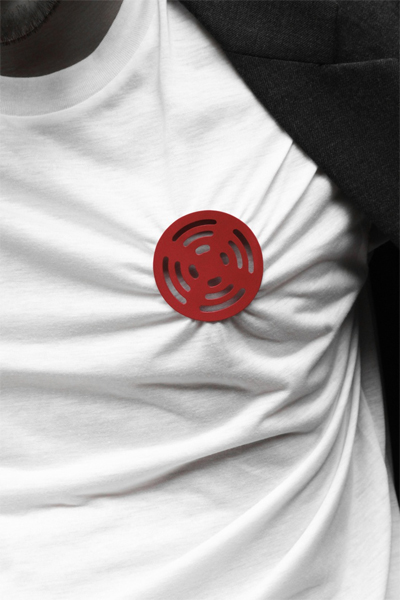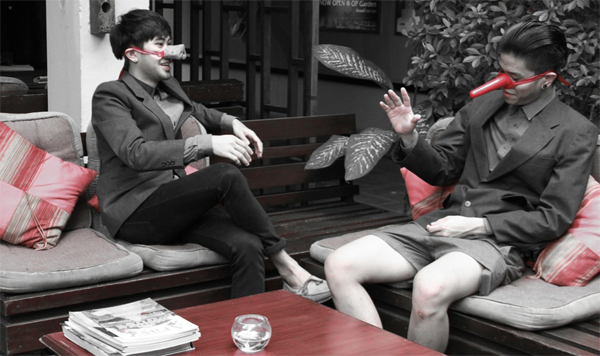
The AJF’s ATTA Gallery is in Bangkok, and Taweesak Molsawat is the artist who is questioning the politics of his country with a show called The Missing Elements of Democracy: Art Jewelry as a Political Critic. This is an excellent example of an exhibition that attempts to use jewelry to political and critical effect. See if you think it succeeds.
Susan Cummins: Taweesak, would you describe some of the missing elements of democracy in Thailand?
Taweesak Molsawat: The word democracy originates from the Greek δημοκρατία (dēmokratía) or ‘rule of the people.’ This is the direct democracy system. The core concept of modern democracy is ‘government of the people, by the people, for the people, shall not perish from the earth’—this is indirect democracy. This concept has not worked as it is supposed to in today’s political system in Thailand. There are many significant factors that cause problems, but this body of work focuses on two elements: the politicians and the people (citizens of Thailand). These two elements—the real representation of the people and an understanding of the true concept of a democratic electoral system—have been missing in Thai government. The politicians are not representatives of the people, and democracy is not just a vote for personal gain.

The AJF’s ATTA Gallery is in Bangkok, and Taweesak Molsawat is the artist who is questioning the politics of his country with a show called The Missing Elements of Democracy: Art Jewelry as a Political Critic. This is an excellent example of an exhibition that attempts to use jewelry to political and critical effect. See if you think it succeeds.
Susan Cummins: Taweesak, would you describe some of the missing elements of democracy in Thailand?
Taweesak Molsawat: The word democracy originates from the Greek δημοκρατία (dēmokratía) or ‘rule of the people.’ This is the direct democracy system. The core concept of modern democracy is ‘government of the people, by the people, for the people, shall not perish from the earth’—this is indirect democracy. This concept has not worked as it is supposed to in today’s political system in Thailand. There are many significant factors that cause problems, but this body of work focuses on two elements: the politicians and the people (citizens of Thailand). These two elements—the real representation of the people and an understanding of the true concept of a democratic electoral system—have been missing in Thai government. The politicians are not representatives of the people, and democracy is not just a vote for personal gain.
You say in your artist’s statement: ‘In this body of work, I am particularly interested in exploring jewelry and the body of the wearer as a way of communicating a political message.’ Why did you settle on jewelry as a form of communication in this way? What are its strengths as an art form?
Taweesak Molsawat: Art communicates through visual and non-visual means. The subject matters of art originate from culture and society, therefore art is an instrument to critically and creatively examine culture and society.
In today’s commodity society, one is constantly moving. The way one dresses is the way one expresses oneself. Therefore, and unavoidably, one’s body has become a moveable channel for cultural communication. One cannot change the politicians and the political system, but one can influence the individual and people around them at intimate levels. One can communicate and educate people about the missing elements in democracy. Jewelry is an effective art form for direct and emotional communication to the public on a deeper personal level than other media. Jewelry can communicate to one person at a time, saying a lot without speaking.
In another quote from your statement, you say:
‘The frustration that has grown in the hearts of those raped of their rights is the starting point for this new creative research—one that uses art, in this instance jewelry, as a way of criticizing the political system and encouraging those without a voice to confront the current situation.’
Do you think jewelry is capable of criticizing the political system?
Taweesak Molsawat: Yes, I absolutely think so. Jewelry has been a vital part of cultural, social, economical, and political expression since the day man started to put things on the body. This is particularly true in today’s society. The role of jewelry in this body of work is to convincingly criticize the political system.
With the development of technology and capitalism, commercial jewelry has focused on simple design elements and production, typically making use of precious materials and branding strategies in a vacuum. This is heightened by our culture of branding. The definition and function of jewelry has changed, becoming limited. There is no apparent regard for its content, context, or relation to social, cultural, and political concepts. Without meaning, jewelry items become insignificant objects. An ideology behind jewelry should exist and join with the concepts mentioned above. I intend this work to act as a silent speaker and directly communicate with the public using a visual and emotional language that is deep, loud, and contemporary.

Describe one or more of your pieces, and explain how it communicates this message.
Taweesak Molsawat: I put a spin on contemporary, recognizable elements and use contrasting approaches to create irony and to act as cultural signifiers. My goal is to question and stimulate the viewers’ and wearers’ thinking through self-discovery. In addition, the installation of the pieces, the physical wearing of them, and the conceptual participation combine to create a space for contemplation. Wearers and viewers can question (symbolically and metaphorically) the missing elements of democracy through their own interpretations. By thinking and questioning, the viewers will start to critique what has happened to Thai democracy.
Additionally, there is a small flower pattern on each piece. This motif is from the constitution of Thailand. It signifies how to be a good representative of the people. I used this pattern to create both direct and metaphorical self-discovery. It connects the subject matter to the work, the viewers, and the wearers.

This body of work is a conceptual statement, but it doesn’t necessarily have commercial value. How can your message become ‘moveable media,’ as you intend, if no one wears it out into the world? Has anyone bought the work?

However, it is essential that my work be seen in order to function as ‘movable media’ and communicate to the public. There are many ways to achieve this. A direct way of communication is to wear the work on the body in public. An indirect way to communicate is to interact with the work at an exhibition by wearing a piece and/or posing with it and taking photograph. Images of the work on the body are then published through other channels, such as newspapers, magazines, Facebook, and websites. Because of this, the focus of the work remains a conceptual statement of jewelry as moveable media.
This jewelry is worn on the body to communicate to the world. This body of work is intended to be a catalyst. Its wearers have a will to speak up with the artistic voice. In this case, artistic strategy is the effective communicator rather than the commercial constructs of quantity or precious materials. The general public is allowed to engage with the work, to become a part of it, to encounter problems, to feel a sense of significance, and to associate jewelry with deeper ideas.

There are two approaches to creative work in this exhibition. The Missing Elements of Democracy No. 1 emphasizes a new function and role for jewelry as it relates to content, meaning, and the body, while The Missing Elements of Democracy No. 2 focuses on visual communication through traditional jewelry.
Does the placement of the piece on the body influence the interpretation? Please give me an example of how that works.
Taweesak Molsawat: Yes, it does. The placement of my work on the body is significant to the interpretation of its content and its context as jewelry. Each particular position is suggestive. For example, see the images shown. Without wearing the pieces between fingers, the work remains beautiful in form, color, and content. It only suggests wearability as a hand ornament and thereby a context as jewelry. Without the body, the objects become mysterious and raise questions. (Each piece has a certain visual element to connect it to the body). When the four pieces are worn between fingers, the wearer cannot use her hand to do anything except look pretty. This experience is very important for the wearer. The act of wearing my work in a particular position on the body is intended to be a metaphor and create a clearer interpretation for the viewer.
I love the idea that you consider what you are doing creative research. How does your analysis and interpretation of the data inform the design process?
Taweesak Molsawat: As an artist and educator in Thailand, I have to document and communicate my creative process to the public and in an academic realm. Creative research is not only a way to put the entire process into writing, but very helpful and important for an artist to have a clear direction of his exploration and to broaden his creative knowledge and wisdom.

How does analysis and interpretation of data inform the design process?
Collecting (reviewing related literature and field surveys), analysis, synthesis, and conclusion of data are very important steps for my work prior to any creative design process. For this body of work, the design direction and process was based on the conclusion from both qualitative and quantitative analysis. The two design concepts or keywords of design for this body of work are metaphor and paradox. The work is intended to stimulate questions of the viewers about the differences of the known elements, the differences in details, and the differences in contexts. This design strategy allows the audience to question the perverted establishment of democracy through the metaphor of the work. Viewers are invited to investigate the paradox of the work as it creates new forms and contents for communication and urges viewers to receive the message through their own thought process.
My research paper is to be used for academic reference and presented only after the creative work has been exhibited and is fully functional as an artwork. Otherwise, the beauty of mystery and creative thinking will be lost. And, what is the point of creating art? Art is another level of communication in its own right. When my work is exhibited, I will not provide any specific information to the wearers and viewers. Instead, I will let them interact with the work psychologically and physically to discover the message themselves.
Thank you.





